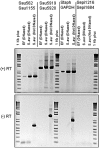Direct demonstration of viable Staphylococcus aureus biofilms in an infected total joint arthroplasty. A case report
- PMID: 18676908
- PMCID: PMC2729478
- DOI: 10.2106/JBJS.G.00838
Direct demonstration of viable Staphylococcus aureus biofilms in an infected total joint arthroplasty. A case report
Figures





Similar articles
-
Arthroscopic debridement and irrigation of periprosthetic total elbow infection.Arthroscopy. 2006 Oct;22(10):1140.e1-3. doi: 10.1016/j.arthro.2005.06.037. Arthroscopy. 2006. PMID: 17027419
-
[Total elbow arthroplasty in the salvage of pseudarthrosis of a supracondylar humerus fracture].Z Orthop Ihre Grenzgeb. 1995 Jul-Aug;133(4):328-9. doi: 10.1055/s-2008-1039801. Z Orthop Ihre Grenzgeb. 1995. PMID: 7571800 German.
-
Linked elbow replacement: a salvage procedure for distal humeral nonunion.J Bone Joint Surg Am. 2008 Sep;90(9):1939-50. doi: 10.2106/JBJS.G.00690. J Bone Joint Surg Am. 2008. PMID: 18762655
-
Management of the flail elbow.Hand Clin. 2008 Feb;24(1):113-24. doi: 10.1016/j.hcl.2007.11.006. Hand Clin. 2008. PMID: 18299025 Review.
-
Total elbow arthroplasty for the treatment of insufficient distal humeral fractures. A retrospective clinical study and review of the literature.Injury. 2009 Jun;40(6):582-90. doi: 10.1016/j.injury.2009.01.123. Epub 2009 Apr 24. Injury. 2009. PMID: 19394013 Review.
Cited by
-
Reducing Staphylococcus aureus biofilm formation on stainless steel 316L using functionalized self-assembled monolayers.Mater Sci Eng C Mater Biol Appl. 2013 May 1;33(4):2059-69. doi: 10.1016/j.msec.2013.01.023. Epub 2013 Jan 18. Mater Sci Eng C Mater Biol Appl. 2013. PMID: 23498233 Free PMC article.
-
Biophysics of biofilm infection.Pathog Dis. 2014 Apr;70(3):212-8. doi: 10.1111/2049-632X.12118. Epub 2014 Jan 16. Pathog Dis. 2014. PMID: 24376149 Free PMC article. Review.
-
Biofilms in chronic diabetic foot ulcers--a study of 2 cases.Acta Orthop. 2011 Jun;82(3):383-5. doi: 10.3109/17453674.2011.581265. Epub 2011 May 11. Acta Orthop. 2011. PMID: 21561305 Free PMC article. No abstract available.
-
The role of microbial biofilms in prosthetic joint infections.Acta Orthop. 2015 Apr;86(2):147-58. doi: 10.3109/17453674.2014.966290. Epub 2014 Sep 19. Acta Orthop. 2015. PMID: 25238433 Free PMC article. Review.
-
Viable bacteria persist on antibiotic spacers following two-stage revision for periprosthetic joint infection.J Orthop Res. 2018 Jan;36(1):452-458. doi: 10.1002/jor.23611. Epub 2017 Jun 28. J Orthop Res. 2018. PMID: 28543707 Free PMC article.
References
-
- Costerton JW. Biofilm theory can guide the treatment of device-related orthopaedic infections. Clin Orthop Relat Res. 2005;437:7-11. - PubMed
-
- Gristina AG, Costerton JW. Bacterial adherence to biomaterials and tissue. The significance of its role in clinical sepsis. J Bone Joint Surg Am. 1985;67:264-73. - PubMed
-
- Hall-Stoodley L, Hu FZ, Gieseke A, Nistico L, Nguyen D, Hayes J, Forbes M, Greenberg DP, Dice B, Burrows A, Wackym PA, Stoodley P, Post JC, Ehrlich GD, Kerschner JE. Direct detection of bacterial biofilms on the middle-ear mucosa of children with chronic otitis media. JAMA. 2006;296:202-11. - PMC - PubMed
-
- Stewart PS, Costerton JW. Antibiotic resistance of bacteria in biofilms. Lancet. 2001;358:135-8. - PubMed
Publication types
MeSH terms
Substances
Grants and funding
LinkOut - more resources
Full Text Sources
Other Literature Sources
Medical
Molecular Biology Databases

